Safe and Warm Gift Ideas That Work
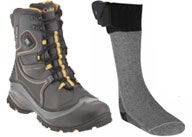
These gifts can save your life or keep you warm on the trail
Having survived a near fatal motorcycle crash earlier this year and undergoing a prolonged recovery, this holiday season has renewed meaning for me. Knowing how quickly and dramatically life can change in a split second tends to have us all focus a bit more narrowly on the here and now. Part of that focus for a powersports enthusiast is recognizing how to ensure the best possible outcome when the unexpected happens.
This time it was a driver deciding to take my share of the roadway while I was still in it. As a much younger man it was riding a sled a few inches too wide on an icy groomed corner and mating that sled to a large trailside oak, which never moved. If you’ve ridden for a few years, there have been near misses, either of your own doing or not. As veteran motorcyclists always say, “There are two kinds of riders: Those who’ve crashed and those who are waiting to crash.” It’s a bit fatalistic, perhaps, but generally true and it actually carries over to snowmobiling and ATVing as well.
When the accident happens, it helps to be ready for it and a little pre-planning can mitigate some aspects of the personal damage. For example, there’s the obvious of wearing the right gear — helmet, good eyewear, protective armor vest for the truly aggressive rider, and some form of medical identification.
Medical ID
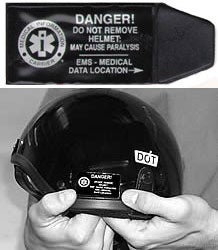 This Medical Information Carrier System that is sold through Whitehorse Gear for $1.99 per unit.
This Medical Information Carrier System that is sold through Whitehorse Gear for $1.99 per unit.One holiday gift that you might consider would be the Medical Information Carrier System that is sold through Whitehorse Gear for US$1.99 each.
This simple but effective device consists of a polyolefin film data form, a heavy-duty neon orange carrier, high-tech tape, and a reflective helmet decal. You simply use a ballpoint pen to print your medical and emergency contact information on the data form, which is then tucked into the orange carrier. The carrier can be affixed to the inside of the helmet or on the outside.
When I had my accident the emergency room attendants were able to access my data and quickly identify a major allergy, know of specific medications and conditions as well as know exactly who to contact.
This simple system provides crucial information that you write onto a tear-resistant, waterproof form that fits into the one-inch by two-inch vinyl pouch. Since this device is inexpensive, you can easily afford to get one for each of your powersport helmets. They are also useful for your kid’s bicycle or snowboarding helmet as well.
The device was introduced by Pittsburg-based MSA, one of the world’s leading manufacturers of safety products.
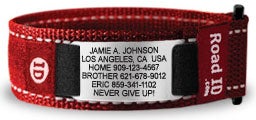 The Road ID fits your wrist and comes in a number of color options.
The Road ID fits your wrist and comes in a number of color options.Another similar product — but a bit more involved in its construction and wearability — is the Road ID, a wearable wrist bracelet with up to seven personalized lines of laser-engraved text. The adjustable Wrist ID Sport comes in three sizes from small to extra-large and in six colors.
There is also an interactive version that incorporates an “emergency response profile” that is available to first responders 24/7. One of the laser-engraved lines is used to provide instructions to rescue personnel on how to retrieve your information.
The website RoadID.com describes and compares the company’s product and explains pricing.
We have used the simpler — though longer named — Medical Information Carrier System and can vouch for its usefulness in time of an emergency. Simple, low cost and life-saving effective, we heartily recommend this product and hope you never use it!
Hot Boots
Another product that we have used and would recommend is Columbia Sportswear’s hot new electrically heated boots, the Men’s Bugathermo Techlite. Last season we told you about the original Bugathermo, which Columbia called the “first high-performance winter boot with an integrated heating system.”
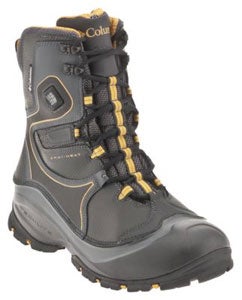 Columbia Bugathermo Techlite heated boots weigh just over a pound.
Columbia Bugathermo Techlite heated boots weigh just over a pound.Another point that we need to make is the great customer support offered by Columbia. You see, last year we bought the initial heated Bugathermo specifically to use on our snowmobiling trips. They worked great. Until the “problem” arose. Seems that where the recharging cord attached to the boot was a problem. The electrical fitting broke after a few rides and came unsoldered. While we could see the problem and thought we could fix it by simply resoldering it, the reality was we couldn’t. Because we had paid full price for these boots, we notified Columbia of the problem. While expecting a so-so response to our problem, Columbia surprised us with concern and a quick willingness to ship us out a replacement boot — or giving us the option to wait and get a brand new next year’s model with a completely revised heating and charging system. We decided to wait, after all why get a replacement boot that had the same potential to go bad as the original? We’re glad we waited.
In the past having heated boots wouldn’t have mattered. My basic Sorel felt-lined snow boots worked just great. Replace the liners every decade or so and we were in business. But, since the aforementioned motorcycle crash left my right foot with seriously revised circulatory “wiring” and more metal screws and plates than original bone mass, keeping the foot and toes warm has become an issue. So, for me, the option of heated boots or heated socks has become a necessity.
This second generation of Columbia boots is incredible. The entire recharging of the heating element was completely revised and now consists of boot-mounted batteries, while still offering three levels of push-button heat available. Plus, these boots, including the removable rechargeable batteries, are substantially lighter than my old Sorels.
The Techlite is built with Columbia’s most advanced technical winter boot tooling and a lightweight cushioning footbed and midsole. The boot features a lightweight waterproof thermal rubber shell and rustproof alloy gaiters, which make the boot excellent for snowmobiling. We’ve found that the first or second heat setting has been ample when snowmobiling — or plowing snow with our ATV.
Having enjoyed the benefits of both generations of Columbia heated hoots, we readily admit to preferring the latest version, which weighs just over a pound. The boot print comes with a very aggressive Omni-Grip traction pattern and lightweight Techlite shell that protects from moisture and cold. With 200 grams of Thinsulate insulation the boots are rated to -25 degrees Fahrenheit.
You can explore the benefits of this serious winter footwear at Columbia.com.
Warm Toes
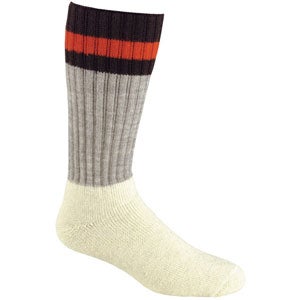 Plush outdoor socks like the Fox River design combine warmth with wicking away moisture.
Plush outdoor socks like the Fox River design combine warmth with wicking away moisture.If you find the idea of heated boots a bit too much, then we can recommend some other warm footwear. We have tested all manner of winter socks over the years. Wigwam makes a great product, but so do others. In fact, we recently stumbled across Fox River products and have a new favorite in plush winter footwear. Founded a century ago in northern Wisconsin, but currently based in Osage, Iowa, Fox River offers a variety of socks ranging from hiking to cold weather footwear.
We’ve experimented with a few of the Fox River products and, for our snowmobiling or winter socks, have settled on the Outdoor Sox. This model features an extra heavyweight design of pre-shrunk worsted wool and ribbed legs to stimulate circulation. Other choices are the company’s Wick Dry Tamarack of extra heavy Merino wool, which adds warmth and wicking.
Why are good boots and socks so important? Comfort and warmth are obviously key, but Fox River notes that the average person logs up to 70,000 miles on their feet in a lifetime. In a year’s time feet sweat up to 15 gallons per foot, with about half being absorbed by a person’s socks. For snowmobilers those are gallons of moisture that can make for very cold feet and a big reason for choosing premium quality footwear that wicks moisture from the feet. If you want to know more about the Fox River option, check our FoxSox.com.
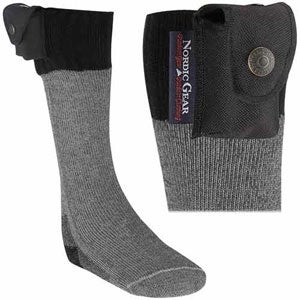 Riders with cold feet can add the warmth of electrically heated socks like the battery-powered Nordic Gear Lectra Sox.
Riders with cold feet can add the warmth of electrically heated socks like the battery-powered Nordic Gear Lectra Sox.Just as you can get heated boots, you can also keep your feet warm via the hunter and fisherman’s secret of electrically heated socks. Places such as fishing outlets like the Bass Pro Shops and sporting goods stores like Sports Authority carry battery-powered electrically heated footwear. Lectra Battery Heated Boot Style Socks from Nordic Gear retail for up to US$25. The key to the heated sock is a recessed channel built into the leg and toe area to house the heating element. This brand uses Hollofil insulation material to wick moisture.
Lectra Socks utilize a single D-cell battery per sock that is carried in an accessible pouch for heat control.
Bass Pro Shops carry “RedHead Extreme Heated Socks with a low-voltage design that heats the toes and will run up to six hours on two D alkaline batteries. These socks retail for about US$20 per pair.
Of course, since many modern snowmobiles — especially trail touring models — come with accessory plugs, you can hook electrically heated clothing directly into your sled. That means that wearing heating jackets, vest and gloves like those supplied by companies like Gerbings is also a newfound reality.
As you can see, this holiday season gives us options for safety and comfort that not only make great gifts to receive but to give to loved ones with whom we want to grow old.
So, from us at Snowmobile.com, enjoy the holidays — safely and warmly.
Related Reading Holiday Gift Guide Holiday Gift Ideas: For Him Holiday Gift Ideas: For Her Top Deep Powder Products Best Performance Parts for Powder Sleds



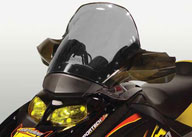

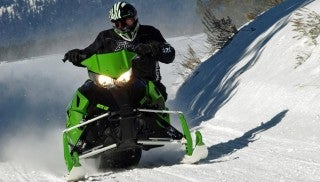


 Your Privacy Choices
Your Privacy Choices